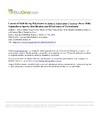Identificador persistente para citar o vincular este elemento:
https://accedacris.ulpgc.es/jspui/handle/10553/46543
| Título: | Control of shell-boring polychaetes in Haliotis tuberculata coccinea (Reeve 1846) aquaculture: Species identification and effectiveness of Mebendazole | Autores/as: | Bilbao Villena, Amaia Núñez, Jorge Viera, Mara Del Pino Sosa, Beatriz Fernández-Palacios, Hipólito Hernández-Cruz, Carmen María |
Clasificación UNESCO: | 251092 Acuicultura marina | Palabras clave: | Abalone Haliotis tuberculata coccinea Polydora sp. Mebendazole |
Fecha de publicación: | 2011 | Editor/a: | 0730-8000 | Publicación seriada: | Journal of Shellfish Research | Resumen: | The experimental culture of Haliotis tuberculata coccinea is carried out at the Institute of Marine Science of Canary Islands (Gran Canaria, Spain) based on specimens captured in their natural habitat and conditioned as broodstock. In 2008, an outbreak of shell-boring polychaetes affected the culture. This study aims to identify some of the species of shell-boring polychaetes that affect H. tuberculata coccinea and, second, to assess the effectiveness of multiple mebendazole applications for the control of these pests. Mebendazole was applied as baths of Lomper (Esteve Laboratory, Barcelona, Spain) using the concentrations 6 mL/L, 8 mL/L, and 10 mL/L, with 0 mL/L as a control measure. Abalone were exposed to 3 mebendazole baths over a 3-day period (1× 3-h bath applied for 3 consecutive days), as recommended in the drug directions for human use. After each bath, the abalone were returned to their original culture tanks until the following day. After these 3 days, the abalone were kept in their original culture tanks for a term of 1 mo. Each month, as a result of the effect of mebendazole, moribund and/or dead polychaetes became detached from the burrows and were found at the bottom of the tank during the first 15 days after the baths of mebendazole were applied. The polychaetes expelled from the shells were counted, collected, and fixed in 10% buffered formaldehyde for subsequent identification. This process was repeated month after month until no moribund and/or dead shell-boring polychaetes were found after the application of the baths of mebendazole. The shell-boring polychaete species was identified as Polydora hoplura (Claparède 1870). The efficacy rate of Lomper was around 99% in all the concentrations tested when it was applied during a 7-mo term (each month, 1 bath was applied for 3 consecutive days), and abalone mortality was limited to highly infested animals only. Monitoring of abalone weight gain suggested that the mebendazole treatments did not affect growth significantly during the study period. | URI: | https://accedacris.ulpgc.es/handle/10553/46543 | ISSN: | 0730-8000 | DOI: | 10.2983/035.030.0219 | Fuente: | Journal of Shellfish Research [ISSN 0730-8000],v. 30(2), p. 331-336 |
| Colección: | Artículos |
Citas SCOPUSTM
9
actualizado el 08-jun-2025
Citas de WEB OF SCIENCETM
Citations
8
actualizado el 08-jun-2025
Visitas
97
actualizado el 06-jul-2024
Descargas
226
actualizado el 06-jul-2024
Google ScholarTM
Verifica
Altmetric
Comparte
Exporta metadatos
Los elementos en ULPGC accedaCRIS están protegidos por derechos de autor con todos los derechos reservados, a menos que se indique lo contrario.
